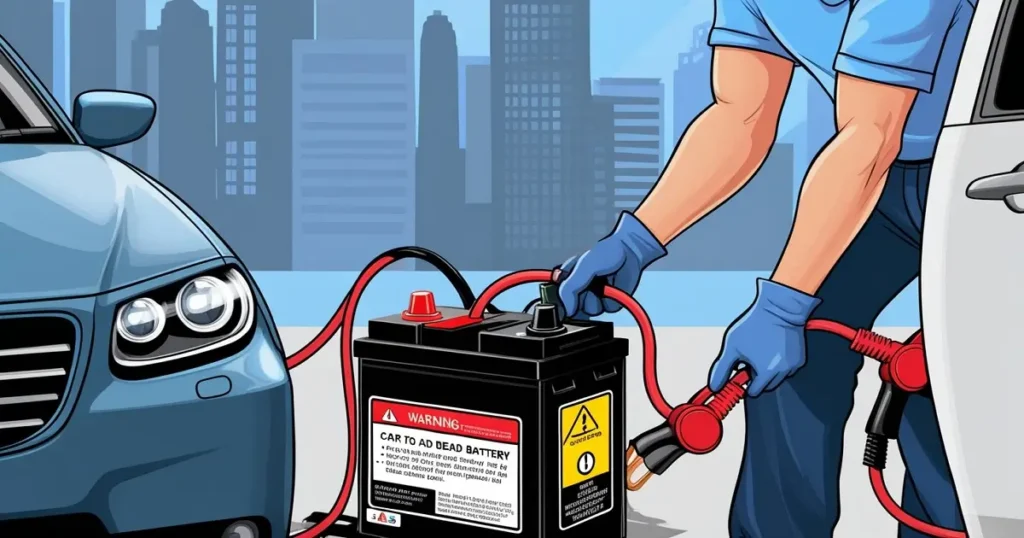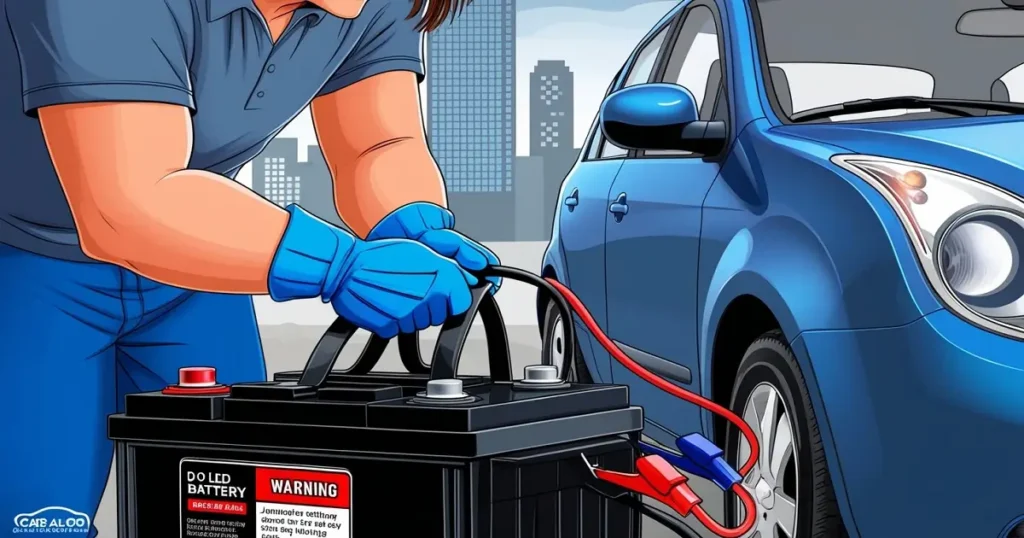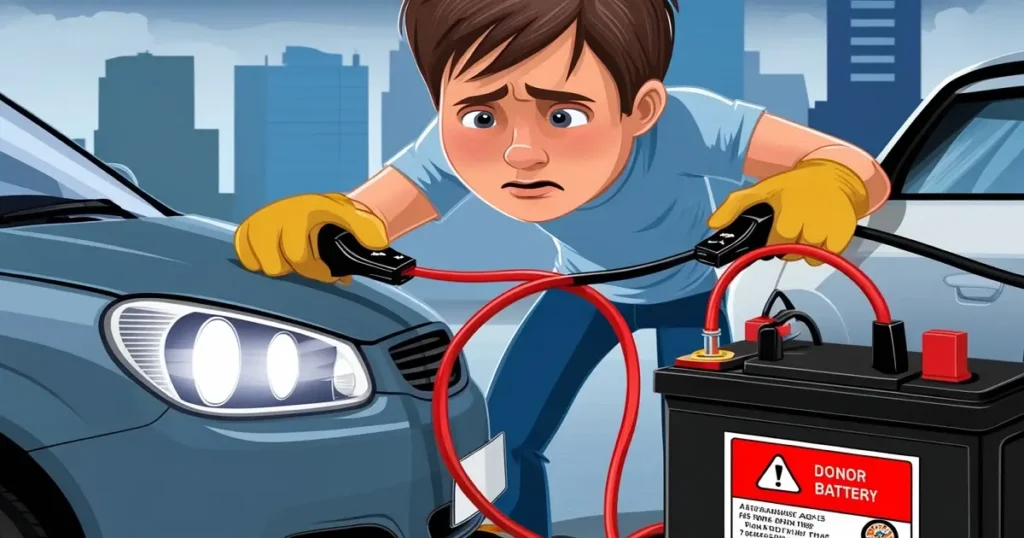Introduction
Picture this: You’re running late for work, you finally get to your car, turn the key, and… click, click, click. Nothing. A dead car battery is one of those universal frustrations that every driver faces at some point. But here’s the good news: knowing how to jump start a car battery is a superpower that can save your day, your wallet, and your sanity. It’s not a complicated magic trick reserved for professional mechanics; it’s a simple, powerful skill you can learn in minutes. In this guide, we’re going to walk through everything you need to know, from the basics to pro tips, in a friendly, easy-to-follow way. Forget the stress and the expensive tow truck calls. By the end of this, you’ll be ready to tackle a dead battery with confidence. Let’s get your car—and your day—back on the road!
Table of Contents
What is a Car Battery Jump Start?
Think of your car battery as the heart of your vehicle’s electrical system. It provides the big burst of energy needed to wake up the engine and get it running. A jump start is like giving that heart a defibrillator shock. By connecting your dead battery to a good battery (usually from another car) using special cables called jumper cables, you transfer enough energy to wake your battery up and get the engine to turn over. It’s a simple concept that has saved countless drivers from being stranded. It’s a fundamental skill, like knowing how to change a tire. Ever wonder why we call it “jumping” a car? It’s because you’re making the electricity jump from one battery to another!

Why You’ll Love Knowing How to Jump Start a Car Battery
Let’s be real—you won’t love having a dead battery. But you will absolutely love the feeling of being prepared and self-reliant when it happens.
- It Saves You Money: Calling a tow truck or a roadside assistance service can cost a pretty penny and take hours. Knowing how to jump start a car battery yourself is free (if you have your own cables) and takes less than 10 minutes.
- It Saves You Time: Instead of waiting helplessly for help to arrive, you can be back on the road in the time it takes to find a friendly driver and pop your hoods.
- It Makes You a Hero: You can now rescue yourself, your family members, or even a stranger in a parking lot. Being the person with the jumper cables and the know-how is a fantastic feeling.
- It’s Empowering: Car trouble can make you feel vulnerable. Turning a potentially stressful situation into a simple, solvable problem gives you a huge confidence boost behind the wheel.
This skill pairs perfectly with other basic car maintenance knowledge, making you a truly savvy and prepared driver.
How to Jump Start a Car Battery: Quick Overview
The basic process of a successful car battery jump start is straightforward: you use jumper cables to create a circuit between the good battery in a donor car and the dead battery in your car. This transfers enough power to crank your engine. Once the engine is running, your car’s alternator takes over and recharges the battery. The entire process, from opening the trunk to getting back in the driver’s seat, typically takes 5-15 minutes. It’s designed to be user-friendly, requiring no technical expertise, just a careful eye and a methodical approach.

Key Features of a Successful Jump Start
A successful jump isn’t just about connecting cables randomly. It’s a precise operation with key “features” that ensure safety and effectiveness:
- Safety First: The paramount feature. This includes protecting yourself from electrical shock and preventing dangerous battery explosions.
- Proper Connection Order: There is a specific, crucial sequence for connecting and disconnecting the jumper cables. Getting this right is the most important part of learning how to jump start a car battery.
- A Healthy Donor Battery: The donor car must have a battery with enough voltage (almost always 12 volts for standard cars) and amperage to provide the necessary jolt.
- Quality Jumper Cables: Not all cables are created equal. Thicker, heavier-gauge cables (lower gauge number, like 4 or 6) are more effective than thin, light ones.
- A Stable Connection: The metal clamps must bite firmly onto clean battery terminals to allow electricity to flow freely.
Step-by-Step Instructions on How to Jump Start a Car Battery
Follow these steps carefully. Remember, the order is everything!
What You’ll Need:
- A set of jumper cables (the thicker, the better).
- A donor car with a good, healthy 12-volt battery.
- Safety glasses and gloves (highly recommended).
- Your car with the dead battery.
Step 1: Safety First and Preparation
- Park the cars correctly: Pull the donor car so it’s facing your car, either nose-to-nose or side-by-side. Make sure the cars are close enough for the jumper cables to reach both batteries easily, but ensure they are NOT touching.
- Engage the parking brakes on both vehicles to prevent any rolling.
- Turn both cars off. Remove the keys from the ignition. Turn off all accessories like headlights, radio, and interior lights in both cars.
- Put on your safety glasses and gloves. Batteries contain acid and can emit explosive hydrogen gas. Safety is non-negotiable.
Step 2: Locate the Batteries and Identify Terminals
- Pop the hoods of both cars and locate the batteries.
- Identify the positive (+) and negative (-) terminals on each battery. They are clearly marked and usually color-coded (red for positive, black for negative). They might have plastic covers; remove these.
- Pro Tip: If the terminals are corroded (with a white, green, or blue crusty substance), try to clean them off with a wire brush or even scrape them with a key. A clean connection is vital for learning how to jump start a car battery effectively.
Step 3: Connect the Jumper Cables (THE RIGHT WAY!)
This is the most critical part. Follow this order exactly:
- Connect RED to DEAD: Take the RED (positive+) clamp and connect it to the POSITIVE (+) terminal of the dead car battery.
- Connect RED to GOOD: Connect the other RED (positive+) clamp to the POSITIVE (+) terminal of the good donor battery.
- Connect BLACK to GOOD: Connect the BLACK (negative-) clamp to the NEGATIVE (-) terminal of the good donor battery.
- Connect BLACK to METAL (Ground): This is the crucial safety step. Instead of connecting the final black clamp to the dead battery’s negative terminal, connect it to an unpainted, metal part of the dead car’s engine block or chassis. A shiny bolt or a metal bracket is perfect. This provides a “ground,” reducing the risk of sparking near the battery, which could ignite hydrogen gas.
Step 4: Start the Donor Car and Charge the Battery
- Start the engine of the donor car.
- Let it run for a few minutes. You might even gently rev the engine slightly to around 1,500-2,000 RPM. This helps the donor car’s alternator send a stronger charge through the cables to your dead battery.
- Let it charge for about 5-7 minutes.
Step 5: Start Your Car (The Moment of Truth!)
- Now, get into your car and try to start it.
- If the engine turns over slowly but doesn’t start, wait another two minutes and try again.
- If it starts immediately, fantastic! Your successful car battery jump start is complete. If it doesn’t start after a few tries, the battery may be too far gone, or you may have another problem (like a bad alternator or starter).
Step 6: Disconnect the Cables (In Reverse Order)
- Once your car is running, it’s time to carefully remove the cables. Do NOT turn your car off yet! The order is the reverse of how you connected them:
- Disconnect the BLACK (negative-) clamp from the grounding point on your car.
- Disconnect the BLACK (negative-) clamp from the donor battery.
- Disconnect the RED (positive+) clamp from the donor battery.
- Disconnect the RED (positive+) clamp from your car’s battery.
- Be very careful not to let the red and black clamps touch each other while any clamps are still connected to a battery.
Step 7: Keep Your Car Running
- Do not turn your car off! Drive your car for at least 20-30 minutes to allow the alternator to fully recharge the battery. If you turn it off too soon, you’ll likely need another jump start for your car battery.

What to Pair a Jump Start With
A traditional jump start with cables is a classic solution, but modern technology offers even better tools to pair with this knowledge:
- A Portable Jump Starter (Jump Box): This is the ultimate modern pairing. These are compact, powerful lithium-ion battery packs with built-in clamps. You don’t need another car! They are a must-have for every trunk or glove box. We’ll cover these more below.
- A Battery Terminal Brush: Keep one in your garage or with your tools. Quickly cleaning corroded terminals ensures a perfect connection every time you need to perform a car battery jump start.
- A Multimeter: A simple, inexpensive tool that lets you check your battery’s voltage. This can help you diagnose a weak battery before it leaves you stranded.
- Roadside Assistance Membership: While knowing how to jump start a car battery is empowering, having a service like AAA or using your insurance’s roadside help is a great backup for more serious issues.
Top Tips for Mastering the Car Battery Jump Start
- Read Your Manual: Some modern cars have specific jump-starting procedures or designated grounding points. The owner’s manual is your best friend.
- Avoid Sparks: The connection order (especially grounding to the chassis, not the battery) is designed to prevent sparks. Always follow it.
- Check Cable Quality: Invest in a good set of 4-gauge or 6-gauge cables that are at least 12 feet long. Cheap, thin cables can overheat and be ineffective.
- Don’t Jump a Frozen Battery: If your battery is frozen (you might see a bulging case), do NOT jump it. It could explode. Thaw it out first.
- If It Doesn’t Work: If you’ve followed all steps correctly and your car still won’t start after a few tries, the problem might not be the battery. It could be a bad alternator, starter, or a deeper electrical issue. It’s time to call a professional.
The Modern Alternative: How to Use a Portable Jump Starter
Portable jump starters (or “jump boxes”) have revolutionized how to jump start a car battery. They are incredibly easy to use:
- Ensure the jump starter is charged. Most have a USB port and can be charged like a phone.
- Plug the included clamps into the jump starter unit.
- Connect the clamps to your car’s battery terminals directly (Red to Positive, Black to Negative). Since the unit is off and the battery is sealed, the risk of spark is much lower.
- Turn the jump starter on.
- Get in your car and start it! It should crank over immediately.
- Once the car is running, turn the jump starter off and disconnect the clamps.
They are safe, convenient, and eliminate the need to find a second vehicle.
How to Stay Updated with Car Battery Care
Car technology is always evolving, and so is battery technology (like Lithium-ion becoming more common). To stay in the know:
- Subscribe to Automotive YouTube Channels: Channels like ChrisFix, Scotty Kilmer, and Engineering Explained offer fantastic, visual guides on everything from basic maintenance to advanced diagnostics.
- Follow Car Care Blogs: Websites like YourMechanic.com, Car and Driver, and J.D. Power publish regular articles on maintenance tips and new tech.
- Join Online Forums: Forums dedicated to your specific car make and model (e.g., Ford F150 Forum, Honda Civic Forum) are treasure troves of owner-specific advice.
- Set a Calendar Reminder: The best way to avoid needing a jump start for your car battery is prevention. Set a reminder to check your battery’s voltage every 3 months and have it professionally tested once a year, especially before winter.
Conclusion
Knowing how to jump start a car battery is more than just a handy skill—it’s a ticket to independence on the road. It transforms a moment of panic into a minor inconvenience. With this friendly guide, you’re now equipped with the knowledge to safely and effectively bring your vehicle back to life. Remember the golden rules: safety first, connect in the right order, and invest in a good set of cables or a portable jump starter. Don’t let a dead battery derail your day. You’ve got this!